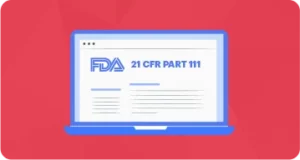Unlock the Keys to Good Manufacturing Practices: A Guide
GMP stands for Good Manufacturing Practices and it is a rigorous set of regulations that must be followed by companies who are involved in the production and manufacturing of products. GMP is an essential part of any industry, from food production to pharmaceuticals, as it helps to ensure the safety of consumers and their health. GMP also helps to guarantee the quality of the products produced, by ensuring they meet all safety and regulatory requirements. Following GMP regulations ensures that products are safe to use and provides confidence to consumers that the product they are using is free from potential hazards. With this comprehensive guide, you will learn the five essential components of GMP so that you can understand and implement this important practice in your own business.
Overview of GMP
Good Manufacturing Practices (GMP) is the systems, processes, and rules in place to ensure that products meet safety, quality, and legal standards. The five essential components of GMP are Quality Assurance, Good Manufacturing Practices, Good Documentation Practices, Quality Control Systems, and Training.
Quality Assurance ensures that a product meets its desired outcome. Good Manufacturing Practices refer to manufacturing processes that are consistent, safe, and reliable. Good Documentation Practices involve the documentation of processes carried out in an organization to ensure accuracy and compliance with regulations. Quality Control Systems monitor and test products to ensure they meet safety and quality standards. Finally, Training ensures employees are adequately trained and knowledgeable on GMP requirements.
Quality Assurance (QA)
Quality Assurance (QA) is an essential component of Good Manufacturing Practices (GMP) and involves ensuring that a product meets or exceeds the specified requirements. QA often involves establishing and following processes, procedures, and standards that ensure products are produced consistently, safely, and reliably. This helps to reduce risk by minimizing human error and environmental impact.
Examples of Quality Assurance activities include inspecting incoming raw materials, approving and verifying process flows, monitoring product production and storage conditions, reviewing supplier relationships, validating quality testing and control systems, and conducting audits. All of these activities are designed to ensure that manufacturers produce a safe and consistent product that is of the highest quality.
QA also ensures that all products meet GMP regulatory requirements and satisfies customer expectations. In addition, Quality Assurance helps to identify, analyze, and address any potential issues before they become a problem. By maintaining high standards of product consistency and quality, manufacturers can ensure that customers receive the best possible product and service.
Good Manufacturing Practices
Good Manufacturing Practices (GMP) are the set of regulations and standards developed by governing bodies to ensure the quality and safety of goods produced. They cover a range of aspects, from the cleanliness and layout of factories to the qualifications and training of employees. GMP is an essential component of any manufacturing environment as it helps to guarantee a consistent quality of production.
In terms of GMP, Good Manufacturing Practices refer to the practices that need to be followed in order to meet all of the regulations and standards set out by the relevant governing body. This can include things like proper sanitation and hygiene protocols, the use of quality control systems, and appropriate employee training. All of these need to be implemented in order for a manufacturing operation to be compliant with GMP guidelines.
Examples of GMP in action include regular maintenance and testing of equipment, the implementation of clear product labeling and packaging, and the establishment of traceability systems. The goal is to ensure that each product produced meets the highest quality standards and the customer receives a product that meets their expectations and is safe to consume.
It is important that all manufacturers follow GMP guidelines in order to protect the safety and quality of their products. By using these procedures and protocols, manufacturers can help to guarantee a consistent level of quality across their entire product range.
Good Documentation Practices
Good documentation practices (GDPs) are an important component of GMP. They are a set of guidelines designed to ensure that all documents related to the manufacturing, testing, and distribution of products are accurate and complete. GDPs help ensure consistency across different departments and personnel, and also make sure regulations and standards are being met.
GDPs involve the use of visual representations, such as charts and graphs, to illustrate process effectiveness. They also include procedures for generating sustainable records that can be used in audits and other assessments. Lastly, they provide guidance on document control, including when changes need to be made and how to ensure that changes are properly documented.
Some examples of GDPs include:
- Establishing procedures for document preparation, revision, and approval
- Establishing a system of document storage and retrieval
- Establishing protocols for making changes to existing documents
- Maintaining records of personnel training
By following the principles of GDPs, companies are able to ensure that all related documents are accurate and up to date. This in turn helps manufacturers meet all applicable regulations, standards, and customer requirements.
Quality Control Systems
Quality Control Systems (QCS) are an essential component of Good Manufacturing Practices (GMP). QCS ensure that products meet standards for safety, quality, and legality. Quality control systems involve testing processes, inspections, and other measures to ensure that products meet the specified requirements.
QCS provide a method to monitor and assess the manufacturing process as it is happening. For example, a QCS may include measures like testing during production, inspecting samples, or examining product data through an audit. By conducting regular quality testing throughout the production process, manufacturers can detect problems early on and make necessary corrections.
It is important to have a reliable and effective QCS in place to make sure that all products manufactured are safe, accurate, and up-to-date. A good QCS should be documented, maintained, and updated to reflect changes in the manufacturing process. As well, any changes or updates to the QCS should be communicated to all relevant personnel.
The main goal of QCS is to identify and minimize risk, improve product reliability, and ensure compliance with industry regulations. With a well-designed and implemented QCS, manufacturers can be confident that their products meet the highest standards of quality and safety.
Training
Training is a key aspect of GMP (Good Manufacturing Practices). It ensures that everyone involved in the manufacturing process has a good understanding of the standards and protocols of GMP. It also helps to protect the safety of products and consumers, as well as creating an efficient, productive and compliant work environment.
Examples of training associated with GMP include employee onboarding and training, training on new technologies, equipment and procedures, and ongoing training to ensure continued compliance. Training should also include general health and safety protocols, such as food hygiene and safety standards and effective product handling procedures.
It is important to provide regular assessments to ensure that all personnel have a thorough understanding of GMP and are using it correctly. A training program should also be in place to address any issues or problems that may arise.
By establishing an effective GMP training program, organizations are able to maintain safe and quality products, and operate in a compliant manner.
GMP regulations are critical for any company that produces and sells products or services. GMP stands for Good Manufacturing Practices and is composed of five essential components – Quality Assurance, Good Manufacturing Practices, Good Documentation Practices, Quality Control Systems, and Training. Collectively, these five components work to ensure that a company’s products and services meet the highest quality standards and protect the safety of their customers.
Quality Assurance is the practice of using rigorous processes to check and evaluate product quality. It involves a set of activities and processes to inspect and verify the quality of materials, products, and services. Quality Assurance focuses on preventing any defects or problems in the production process, ensuring that the final product meets the customer’s expectations.
Good Manufacturing Practices are processes and procedures to ensure the safety, quality, and efficacy of a product. This includes controlling storage and handling conditions of raw materials, utilizing appropriate manufacturing techniques, inspecting production activities, and regularly evaluating product performance.
Good Documentation Practices involve creating detailed records and documents that document a company’s activities and procedures, as well as product information. This helps companies ensure compliance with regulations, track product performance, and improve internal processes.
Quality Control Systems are designed to ensure quality control throughout the production process. Quality Control Systems involve checks on the raw materials, intermediate materials, and final product to ensure that all parts meet the company’s standards.
Last but not least is Training. Training is essential for educating employees on the importance of GMP regulations and how to properly implement them. Employees should understand the purpose of the five components of GMP, their roles in the production process, and the importance of following the guidelines.
In summary, GMP includes five essential components – Quality Assurance, Good Manufacturing Practices, Good Documentation Practices, Quality Control Systems, and Training – which work together to create high-quality and safe products and services. Companies must ensure that they adhere to the principles of GMP to maintain customer trust and protect their reputation.
When implementing GMP, it is important to be well informed and have the right resources at hand. To help you stay on top of the latest industry updates, you can visit the website of the International Society for Pharmaceutical Engineering (ISPE). Here you can find useful information on GMP guidelines and best practices. Additionally, regulatory agencies such as the Food and Drug Administration (FDA) provide access to detailed guidance documents on GMP that can greatly assist in creating a safe and effective quality control system. Finally, there are several reputable publications including books and journals which cover the topic in depth. With all these resources available, you can easily stay abreast of any changes or updates in the field of GMP.
GMP, or Good Manufacturing Practices, is a set of guidelines and regulations that are used in the food and pharmaceutical industry to ensure safety and quality assurance in products. Commonly asked questions about GMP include: What are Good Manufacturing Practices? What do they consist of? Are there any requirements I need to be aware of?
These and other frequently asked questions can be found in this Comprehensive Guide to 5 Essential Components of GMP. In this guide, we will cover Quality Assurance, Good Manufacturing Practices, Good Documentation Practices, Quality Control Systems, and Training. We will also provide some useful resources and a glossary to explain technical terms.
By the end of this guide, you will have a better understanding of the 5 essential components of GMP and how they relate to each other. Let’s dive into the details and explore what GMP is and why it is important!
Glossary
When discussing GMP, it can be easy to get lost in the jargon and technical terms. To help you navigate through unfamiliar terminology, we have provided some of the most common definitions and concepts used in this guide.
- GMP: GMP stands for Good Manufacturing Practices. It is an internationally recognized system to ensure production processes, services and products meet a certain level of quality.
- Quality Assurance: Quality Assurance is a process that involves monitoring and evaluating the performance of products and services. It is used to ensure that the quality specifications are being met.
- Good Manufacturing Practices: Good Manufacturing Practices are industry-specific rules and regulations to help manufacturers produce safe, high-quality products.
- Good Documentation Practices: Good Documentation Practices are a set of guidelines to ensure effective documentation and records management. It ensures that data is accurate, secure and regularly updated.
- Quality Control Systems: Quality Control Systems are methods of assessing and controlling the quality standards of products and services. This includes inspections, testing and reviews.
- Training: Training is the process of providing employees with the skills and knowledge needed to perform their job properly. It is an essential part of any GMP system.
It is important to understand the five essential components of GMP in order to have a successful and compliant business. By following the knowledge covered in this guide, you will have the tools to create a system with the highest standards of quality assurance, manufacturing practices, documentation practices, control systems, and training.
Now that you have the information to make sure your business complies with the GMP standards, it’s time to take action! Start putting into practice what you have learned and ensure that your business creates the best quality products and services. Keep the useful resources that we have provided handy for future reference if needed.
Have any questions or concerns? We have included a FAQ section to provide clarity on any doubts you may have. Congrats on taking the first step towards GMP compliance success!
FAQs
1. What is GMP?
Good Manufacturing Practices (GMP) are a set of protocols and guidelines set by regulatory authorities governing the manufacturing process of products for human or animal consumption.
2. What are the 5 Essential Components of GMP?
The 5 Essential components of GMP are Quality Assurance, Good Manufacturing Practices, Good Documentation Practices, Quality Control Systems, and Training.
3. What is Quality Assurance?
Quality Assurance (QA) is the process of consistently monitoring and evaluating a product in order to ensure that it meets the desired quality standards.
4. What are Good Manufacturing Practices?
Good Manufacturing Practices (GMP) are the industry regulations that require manufacturers to maintain proper production, packaging, and storage procedures to ensure the safety and quality of their products.
5. What are Good Documentation Practices?
Good Documentation Practices (GDP) are a set of guidelines for documenting manufacturing processes and activities in order to ensure product integrity and compliance with laws and regulations.
6. What are Quality Control Systems?
Quality Control Systems (QCS) are a set of procedures and methods used to measure and control the quality of products throughout the manufacturing process. These systems are designed to ensure that any errors or non-conformance issues are detected and corrected quickly.
7. What is Training?
Training is the process of teaching team members the skills necessary to carry out their role in the company, and covers both the technical aspects of the job as well as the processes and procedures for following quality standards.





